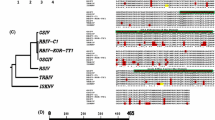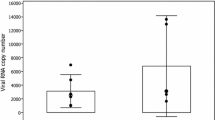Abstract
Iridoviruses are large DNA viruses that infect invertebrates and poikilothermic vertebrates, and result in significant economic losses in aquaculture production, and drastic declines in amphibian populations. Soft-shelled turtle iridovirus (STIV) is the causative agent of severe systemic diseases in farm-raised soft-shelled turtles (Trionyx sinensis). In the present study, the mechanisms of STIV-induced cell death and the roles of the mitogen-activated protein kinase (MAPK) signaling pathway were investigated. STIV infection evoked typical apoptosis in fish cells, as demonstrated by the formation of apoptotic bodies, positive terminal deoxynucleotidyl transferase-mediated nicked-end labeling, and caspase-3 activation. The translocation of cytochrome c from mitochondria to cytoplasm, and caspase-9 activation suggested that a mitochondria-mediated pathway was involved in STIV-induced apoptosis. Moreover, MAPK pathways, including extracellular signal-regulated kinase (ERK), c-Jun N-terminal kinase (JNK) and p38 MAPK signaling were activated during STIV infection. Using specific inhibitors, we found that MAPK signaling molecules, including ERK, JNK and p38 MAPK, were important for virus release, whereas, only ERK and p38 MAPK were involved in STIV-induced apoptosis by modulating caspase-3 activity. Taken together, our findings shed light on the roles of the MAPK signaling pathway in iridovirus-induced apoptosis and virus replication, which provides new insights into understanding iridovirus–host interaction.







Similar content being viewed by others
References
Williams T, Barbosa-Solomieu V, Chinchar VG (2005) A decade of advances in iridovirus research. Adv Virus Res 65:173–248
Chen ZX, Zheng JC, Jiang YL (1999) A new iridovirus isolated from soft-shelled turtle. Virus Res 63:147–151
Huang Y, Huang X, Liu H, Gong J, Ouyang Z, Cui H, Cao J, Zhao Y, Wang X, Jiang Y, Qin Q (2009) Complete sequence determination of a novel reptile iridovirus isolated from soft-shelled turtle and evolutionary analysis of Iridoviridae. BMC Genomics 10:224
Chinchar VG, Bryan L, Wang J, Long S, Chinchar GD (2003) Induction of apoptosis in frog virus 3-infected cells. Virology 306:303–312
Huang YH, Huang XH, Gui JF, Zhang QY (2007) Mitochondrion-mediated apoptosis induced by Rana grylio virus infection in fish cells. Apoptosis 12:1569–1577
Chitnis NS, D’Costa SM, Paul ER, Bilimoria SL (2008) Modulation of iridovirus-induced apoptosis by endocytosis, early expression, JNK, and apical caspase. Virology 370:333–342
Gougeon ML, Piacentini M (2009) New insights on the role of apoptosis and autophagy in HIV pathogenesis. Apoptosis 14:501–508
Clarke P, Tyler KL (2003) Reovirus-induced apoptosis: a minireview. Apoptosis 8:141–150
Ameisen JC, Pleskoff O, Lelièvre JD, De Bels F (2003) Subversion of cell survival and cell death: viruses as enemies, tools, teachers and allies. Cell Death Differ Suppl 1:S3–S6
Dong C, Davis RJ, Flavell RA (2002) MAP kinases in the immune response. Annu Rev Immunol 20:55–72
Sumbayev VV, Yasinska IM (2006) Role of MAP kinase-dependent apoptotic pathway in innate immune responses and viral infection. Scand J Immunol 63:391–400
Wei L, Liu J (2009) Porcine circovirus type 2 replication is impaired by inhibition of the extracellular signal-regulated kinase (ERK) signaling pathway. Virology 386:203–209
Xie J, Ajibade AO, Ye F, Kuhne K, Gao SJ (2008) Reactivation of Kaposi’s sarcoma-associated herpesvirus from latency requires MEK/ERK, JNK and p38 multiple mitogen-activated protein kinase pathways. Virology 371:139–154
Schümann M, Dobbelstein M (2006) Adenovirus-induced extracellular signal-regulated kinase phosphorylation during the late phase of infection enhances viral protein levels and virus progeny. Cancer Res 66:1282–1288
Si X, Luo H, Morgan A, Zhang J, Wong J, Yuan J, Esfandiarei M, Gao G, McManus BM (2005) Stress-activated protein kinases are involved in Coxsackievirus B3 viral progeny release. J Virol 79:13875–13881
Katsuma S, Mita K, Shimada T (2007) ERK- and JNK-dependent signaling pathways contribute to Bombyx mori nucleopolyhedrovirus infection. J Virol 81:13700–13709
Gravell M, Malsberger RG (1965) A permanent cell line form the fathead minnow (Pimephales promelas). Ann NY Acad Sci 126:555–565
Urushibara N, Mitsuhashi S, Sasaki T, Kasai H, Yoshimizu M, Fujita H, Oda A (2009) JNK and p38 MAPK are independently involved in tributyltin-mediated cell death in rainbow trout (Oncorhynchus mykiss) RTG-2 cells. Comp Biochem Physiol C 149:468–475
Alonso C, Miskin J, Hernáez B, Fernandez-Zapatero P, Soto L, Cantó C, Rodríguez-Crespo I, Dixon L, Escribano JM (2001) African swine fever virus protein p54 interacts with the microtubular motor complex through direct binding to light-chain dynein. J Virol 75:9819–9827
Hernaez B, Escribano JM, Alonso C (2006) Visualization of the African swine fever virus infection in living cells by incorporation into the virus particle of green fluorescent protein-p54 membrane protein chimera. Virology 350:1–14
Chen M, Guerrero AD, Huang L, Shabier Z, Pan M, Tan TH, Wang J (2007) Caspase-9-induced mitochondrial disruption through cleavage of anti-apoptotic BCL-2 family members. J Biol Chem 282:33888–33895
Kroemer G, Galluzzi L, Brenner C (2007) Mitochondrial membrane permeabilization in cell death. Physiol Rev 87:99–163
Yasugi E, Uemura I, Kumagai T, Nishikawa Y, Yasugi S, Yuo A (2002) Disruption of mitochondria is an early event during dolichyl monophosphate-induced apoptosis in U937 cells. Zool Sci 19:7–13
Brookes PS, Yoon Y, Robotham JL, Anders MW, Sheu SS (2004) Calcium, ATP, and ROS: a mitochondrial love-hate triangle. Am J Physiol Cell Physiol 287:C817–C833
Nargi-Aizenman JL, Griffin DE (2001) Sindbis virus-induced neuronal death is both necrotic and apoptotic and is ameliorated by N-methyl-D-aspartate receptor antagonists. J Virol 75:7114–7121
Takahashi MN, Jackson W, Laird DT, Culp TD, Grose C, Haynes JI II, Benetti L (2009) Varicella-zoster virus infection induces autophagy in both cultured cells and human skin vesicles. J Virol 83:5466–5476
Essbauer S, Ahne W (2002) The epizootic haematopoietic necrosis virus (Iridoviridae) induces apoptosis in vitro. J Vet Med B 49:25–30
Hu GB, Cong RS, Fan TJ, Mei XG (2004) Induction of apoptosis in a flounder gill cell line by lymphocystis disease virus infection. J Fish Dis 27:657–662
Lai YS, Chiou PP, Chen WJ, Chen YC, Chen CW, Chiu IS, Chen SD, Cheng YH, Chang CY (2008) Characterization of apoptosis induced by grouper iridovirus in two newly established cell lines from barramundi, Lates calcarifer (Bloch). J Fish Dis 31:825–834
Lee SM, Kleiboeker SB (2007) Porcine reproductive and respiratory syndrome virus induces apoptosis through a mitochondria-mediated pathway. Virology 365:419–434
Hay S, Kannourakis G (2002) A time to kill: viral manipulation of the cell death program. J Gen Virol 83:1547–1564
Choi J, Lee KJ, Zheng Y, Yamaga AK, Lai MM, Ou JH (2004) Reactive oxygen species suppress hepatitis C virus RNA replication in human hepatoma cells. Hepatology 39:81–89
Kominsky DJ, Bickel RJ, Tyler KL (2002) Reovirus-induced apoptosis requires both death receptor- and mitochondrial-mediated caspase-dependent pathways of cell death. Cell Death Differ 9:926–933
Lin CH, Shih WL, Lin FL, Hsieh YC, Kuo YR, Liao MH, Liu HJ (2009) Bovine ephemeral fever virus-induced apoptosis requires virus gene expression and activation of Fas and mitochondrial signaling pathway. Apoptosis 14:864–877
Wada T, Penninger JM (2004) Mitogen-activated protein kinases in apoptosis regulation. Oncogene 23:2838–2849
Monick M, Staber J, Thomas K, Hunninghake G (2001) Respiratory syncytial virus infection results in activation of multiple protein kinase C isoforms leading to activation of mitogen-activated protein kinase. J Immunol 166:2681–2687
Johnson RA, Huong SM, Huang ES (2000) Activation of the mitogen-activated protein kinase p38 by human cytomegalovirus infection through two distinct pathways: a novel mechanism for activation of p38. J Virol 74:1158–1167
Dhanasekaran DN, Reddy EP (2008) JNK signaling in apoptosis. Oncogene 27:6245–6251
Sanna MG, da Silva Correia J, Ducrey O, Lee J, Nomoto K, Schrantz N, Deveraux QL, Ulevitch RJ (2002) IAP suppression of apoptosis involves distinct mechanisms: the TAK1/JNK1 signaling cascade and caspase inhibition. Mol Cell Biol 22:1754–1766
Deveraux QL, Reed JC (1999) IAP family proteins–suppressors of apoptosis. Genes Dev 13:239–252
Lin C, Zimmer SG, Lu Z, REJr Holland, Dong Q, Chambers TM (2001) The involvement of a stress-activated pathway in equine influenza virus-mediated apoptosis. Virology 287:202–213
Banerjee S, Narayanan K, Mizutani T, Makino S (2002) Murine coronavirus replication-induced p38 mitogen-activated protein kinase activation promotes interleukin-6 production and virus replication in cultured cells. J Virol 76:5937–5948
Ndjomou J, Park IW, Liu Y, Mayo LD, He JJ (2009) Up-regulation of hepatitis C virus replication and production by inhibition of MEK/ERK signaling. PLoS One 4:e7498
Ludwig S (2009) Targeting cell signalling pathways to fight the flu: towards a paradigm change in anti-influenza therapy. J Antimicrob Chemother 64:1–4
Acknowledgments
This work was supported by grants from the Knowledge Innovation Program of the Chinese Academy of Sciences (KZCX2-YW-BR-08, KZCX2-EW-Q213), and the National Natural Science Foundation of China (30700616, 30800846, 30725027, 30930070, 30571437).
Author information
Authors and Affiliations
Corresponding author
Rights and permissions
About this article
Cite this article
Huang, Y., Huang, X., Cai, J. et al. Involvement of the mitogen-activated protein kinase pathway in soft-shelled turtle iridovirus-induced apoptosis. Apoptosis 16, 581–593 (2011). https://doi.org/10.1007/s10495-011-0595-z
Published:
Issue Date:
DOI: https://doi.org/10.1007/s10495-011-0595-z




